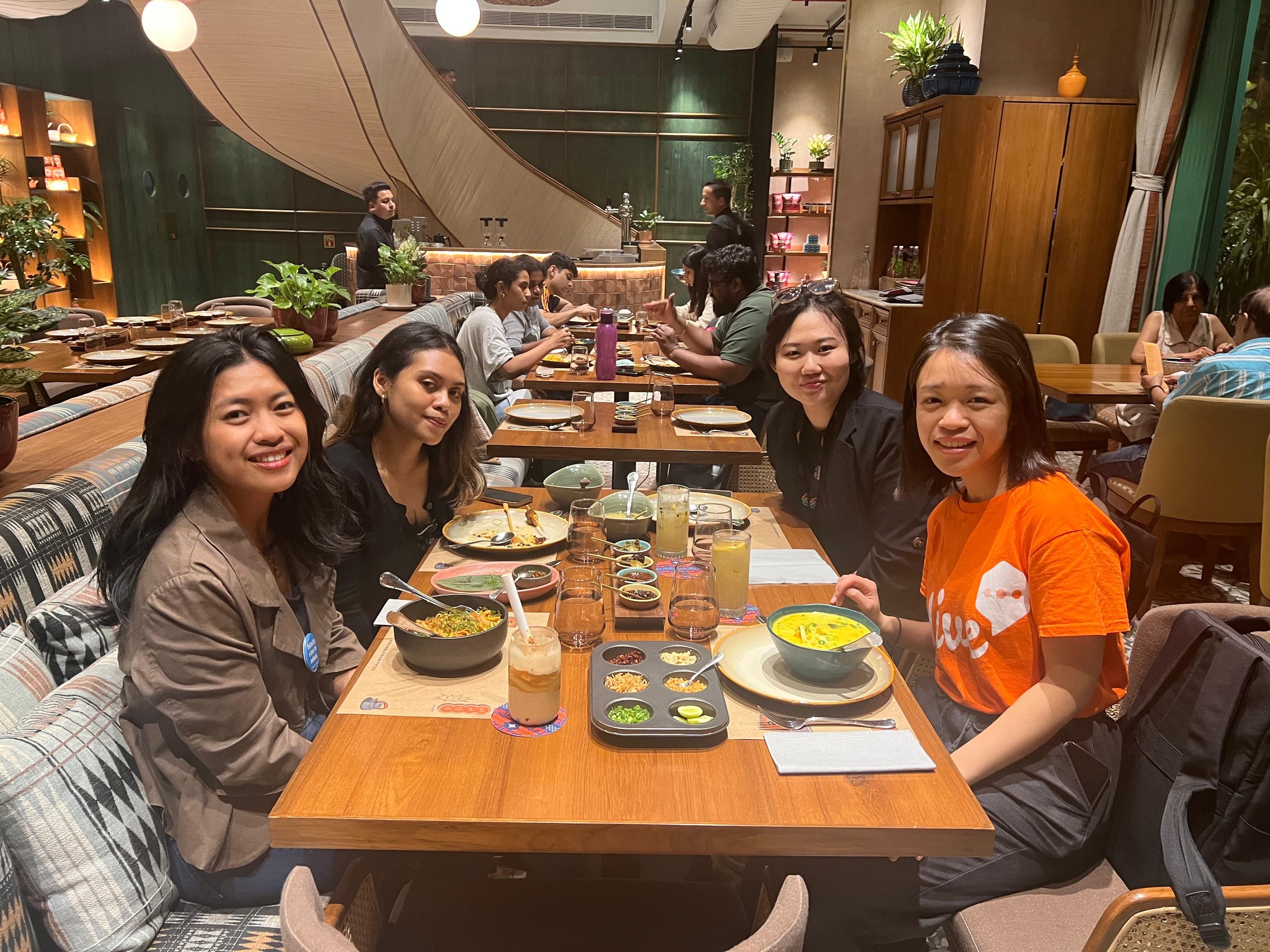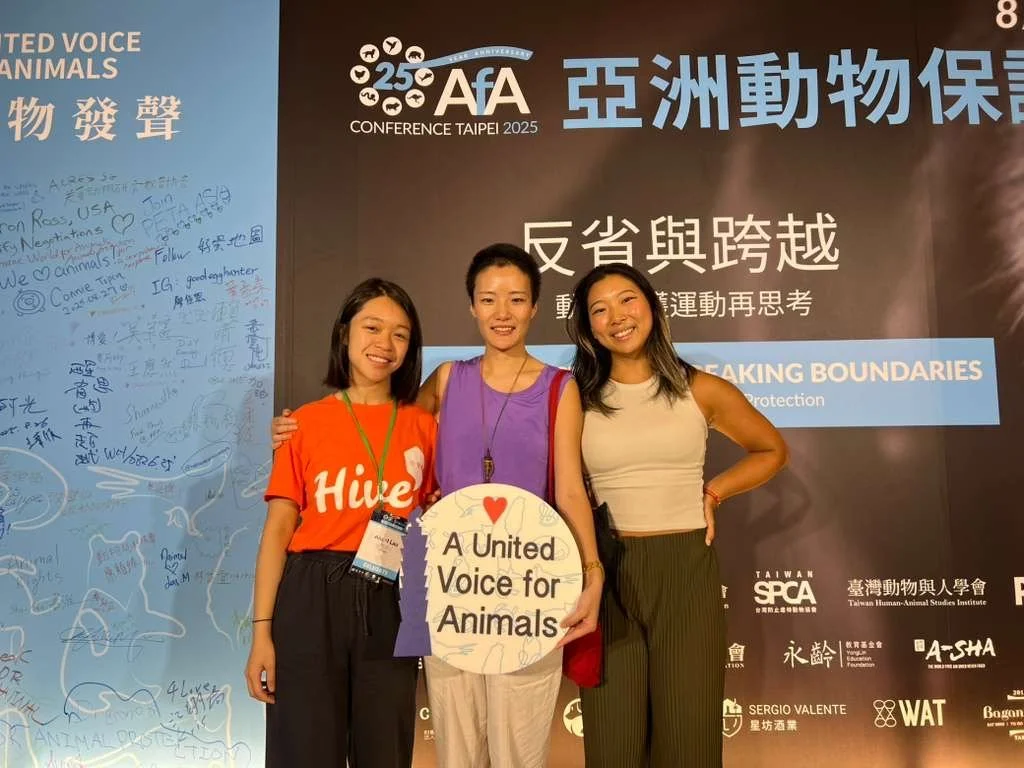Asia Ambassador Program: Five Months of Learning and Growth
Five months into her role as Hive’s Asia Ambassador, Angel shares with Hive’s Community Coordinator, Nazlı, what she’s been learning from connecting advocates across Asia—the progress so far, the uncertainties ahead, and her plans for the next seven months.
Nazlı: To start, could you share what Hive was already doing to support the Asian animal advocacy community, and how that work led to the creation of the Asia Ambassador role?
Angel: We already had an active Asia presence on the Hive Slack, thanks to incredible volunteers like Szuching Chi (channel lead for Asia and China), Aditya SK (channel lead for India), and Abhishek Pandey (who supports the India and Asia channels).
Hive team members also attend regional conferences such as Asia for Animals Day (2023 and 2024), and we’ve partnered with organizations like the Ahimsa Fellowship to onboard their graduates to the Hive community. These efforts laid a strong foundation, and the Asia Ambassador role builds on that to deepen our engagement and support.
Asia is home to over 75% of the world’s farmed animals, including 90% of all farmed fish and 45% of farmed land animals. As economies and incomes in the region grow, so does demand for animal-based products.
We’ve seen incredible work from Asian advocates in our community. At the same time, conversations with movement builders here have made it clear that connection, knowledge, and networking — especially between local and global advocates — are still major unmet needs.
Hive has always aimed to be a truly global community. It takes intentional effort, and the Asia Ambassador role is one way we’re making that happen.
Nazlı: Thanks for that overview! What were you personally excited about in this program? And what uncertainties did you have starting out?
Angel: Asia holds immense potential both in terms of the sheer number of humans and animals, and the early stage of the movement in many countries. There are high-leverage opportunities to shape how farmed animal advocacy develops here.
More personally, I love working at a “meta” level — seeing who’s doing what, where, and connecting people with each other and opportunities, so that they can achieve more together than they could alone.
My main uncertainties were around focus and feasibility. The region is vast and diverse, how do we prioritize? And with this being a 12-month, part-time pilot, what’s realistic to achieve in that time? What are good indicators or proxies that we're on the right track?
Nazlı: Once you stepped into the role, what did your first few months look like?
Angel: It’s been a mix of listening, connecting, and experimenting.
To better understand needs, I’ve had about 15 calls with advocates and organizational leaders across Asia, run surveys among Asian Hivers and non-Hivers, and reviewed existing landscape reports from Animal Advocacy Africa, Animal Alliance Asia, Faunalytics, and Good Growth.
Community-building has been another big piece. I’ve had around 15 calls with Asia-based community members and over 50 one-on-one meetings at major conferences like Asia for Animals and AVA Summit India. I also led a networking meetup at AVA India with ~50 participants and am planning another at EAGxSingapore 2025.
Other activities include:
Supporting consultations for advocates—from movement strategy and career advice to fundraising.
Leading outreach on the Asia front for Hive and Stray Dog Institute’s new Regional Advisory Panels, resulting in over 40 applicants from Asia.
Joining online communities (like WeChat and Facebook groups) to share Hive resources where Slack is less accessible and popular.
Collaborating with our Asia channel leads to strengthen engagement.
Angel at the Asia for Animals Conference and AVA Summit India, in 2025
Nazlı: That’s a huge range of activities! Have you started seeing any concrete outcomes or stories that show early impact?
Angel: Yes, and those stories are the most motivating part of this work!
We’ve logged 9 facilitated connections, 7 consultations, and 2 High Impact Outcomes (HIOs) so far.
One example is Fadilah Rahma, who was preparing for interviews for the Open Wing Alliance Asia-Pacific Membership Lead role. I advised her during the process, and she later secured the role. She even said our support was counterfactually important to her success.
Another is Antonia Chan, who, after a career consultation, started volunteering with Planet for All Hong Kong. These individual stories might seem small, but they show what tailored support and connection can unlock.
We’ve also arrived at experiments we can try, for example:
Country-specific online community building
Targeted outreach focusing on overseas Asian university students
An East Asian channel / regular call
Engagement with near-miss applicants to programs/organizations such as Paro Institute, IFAWF, and the Ahimsa Fellowship
Outreach to and onboarding organizational leaders and effective altruism chapters onto Hive Slack
Asia-specific virtual calls with current Hive community members
Nazlı: Those are great examples. Talking with advocates across such different contexts, what have you learned about their common challenges or needs?
Angel: We hear some common themes, such as eagerness for a more intersectional approach to animal welfare (connecting it to climate, food systems, and social justice), and a strong interest in diversifying beyond Western funding.
We’ve also learned that platform accessibility matters. For example, Slack is banned in China and uncommon in countries like India and South Korea. So instead of inviting everyone to Hive Slack, we’re joining existing local groups on platforms they already use.
Language can be a barrier. Some advocates, for instance, from Taiwan and South Korea, find English-only spaces challenging. We’re exploring ways to make Hive’s resources more multilingual, whether through translated newsletters or events in local languages.
Finally, messaging matters. In some countries, nonprofit work is not seen as prestigious or financially viable, so “join an animal nonprofit” isn’t always the right call-to-action. It might be more effective to support people in learning about effective animal advocacy and finding ways to do good from wherever they are — in business, government, academia, or beyond.
Nazlı: It sounds like these insights are already helping shape your next steps. What specific goals are you aiming to achieve by the end of the pilot year?
Angel: Some of our goals include:
30+ consultations with Asia-based advocates.
30+ strategic connections facilitated within or between Asia and global networks.
15+ High Impact Outcomes logged involving Asia advocates.
Active participation in 5 local or regional online groups.
Growth and engagement in our Asia Slack channels (#r-asia, #r-china, #r-india).
Nazlı: And what’s next — how will you build on this momentum?
Angel: In the next seven months, I’ll keep building on the planned activities and experiments outlined above, identifying the more tractable and promising ones among them.
We’re also seeking to raise $37,200 to extend this program for another year (June 2026 – May 2027). That would allow us to sustain and deepen the program, strengthen Asia-global connections, and test longer-term engagement models.
Nazlı: Before we wrap up, what’s something you’d like readers to take away from this update?
Angel: First, if you care about building a stronger, more connected global movement for farmed animals, please consider donating to Hive during our end-of-year campaign. Your support will directly help sustain programs like this one.
Second, if you’re an advocate based in Asia or want to learn more about this program, reach out to me on Hive Slack or email me at angel[at]joinhive.org. I’d love to chat and explore how we can collaborate.
Thanks for taking the time to read this update, and for everything you do to help build a more connected movement for animals.
Want to stay connected with Hive?
Join Hive Slack here, and stay up to date on the latest via our bi-weekly newsletter, Hive Highlights.





